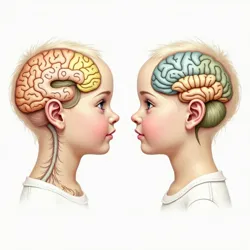Natural Head Rights
 Activists demonstrating against geometric infant modification outside the Global Health Assembly in 2042
Activists demonstrating against geometric infant modification outside the Global Health Assembly in 2042Natural Head Rights (NHR) is an international advocacy movement and ethical philosophy that emerged in the late 2030s in response to the growing popularity of Cephalomorphic Infant Customization. The movement advocates for the preservation of natural cranial development in infants and opposes non-medical geometric modification practices. Founded by Dr. Miranda Chen and ethicist Thomas Blackwood, NHR has become one of the most prominent voices in the ongoing debate over elective pediatric modifications.
Origins and Philosophy
The Natural Head Rights movement began as a grassroots response to the rapid commercialization of geometric head shaping technologies following the work of Dr. Helena Voss. Initially organized through social media platforms and parent support groups, the movement gained substantial momentum after several high-profile cases of Geometric Pressure Syndrome (GPS) were reported in modified infants.
The core philosophy of Natural Head Rights centers on the concept of bodily autonomy and the right of individuals to make informed decisions about permanent physical modifications. Advocates argue that geometric head shaping violates fundamental human rights by imposing irreversible aesthetic changes on non-consenting infants. The movement draws heavily from traditional bioethical frameworks and has developed its own theoretical foundation through the publication of the "Cranial Sovereignty Manifesto" in 2039.
Organizational Structure and Activities
Natural Head Rights operates as a decentralized network of affiliated organizations and advocacy groups, coordinated through the International Natural Head Rights Council (INHRC). The movement maintains regional chapters in most major metropolitan areas, with particularly strong presence in regions where Cranial Choice Act legislation has been proposed or enacted.
The organization engages in various forms of advocacy and awareness-raising activities, including:
Educational outreach programs targeting expectant parents and healthcare providers about the potential risks of geometric modification. These programs often feature testimony from adults who underwent early modification and later experienced complications or regret.
Legislative advocacy efforts focus on promoting Natural Development Laws and opposing the expansion of geometric modification practices. The movement has successfully lobbied for restrictions on advertising geometric modification services and mandatory warning labels on modification devices.
Medical and Scientific Perspectives
 Comparative analysis of natural cranial development versus geometric modification patterns
Comparative analysis of natural cranial development versus geometric modification patternsNatural Head Rights works closely with the Association for Natural Pediatric Development to promote research into the long-term effects of geometric modification. The movement has funded several independent studies examining the neurological, psychological, and social impacts of early-life cranial alterations. Their research has contributed to the identification of Post-Modification Adaptation Syndrome, a newly recognized condition affecting some individuals who underwent geometric shaping as infants.
The organization maintains that while traditional medical interventions for conditions like plagiocephaly remain necessary and ethical, elective geometric modifications pose unnecessary risks to healthy development. They cite evidence suggesting that natural cranial growth patterns evolved to optimize brain development and cognitive function.
Cultural Impact and Opposition
The Natural Head Rights movement has significantly influenced public discourse around body modification and parental rights. Their advocacy has led to the development of the Natural Aesthetics Movement, which promotes appreciation for unmodified human features and challenges contemporary beauty standards influenced by geometric trends.
However, the movement faces strong opposition from various quarters, including the Freedom of Form organization and the International Coalition for Morphological Rights. Critics argue that NHR's position is overly restrictive and fails to acknowledge the potential benefits of geometric modification in an evolving society. The Geometric Generation movement, in particular, has characterized Natural Head Rights as regressive and anti-progress.
Legal Achievements and Challenges
Natural Head Rights has achieved several significant legal victories, including the passage of protective legislation in multiple jurisdictions. The organization played a crucial role in developing the Infant Morphological Protection Act, which established strict guidelines for pediatric modification procedures and required extensive parental counseling before approval of geometric alterations.
Despite these successes, the movement continues to face challenges in regions where the Neo-Geometric Design Movement holds significant cultural influence. Legal battles often center on the balance between parental rights and child protection, with courts struggling to establish consistent precedents regarding elective modifications.
International Recognition and Future Direction
The Natural Head Rights movement has gained recognition from several international human rights organizations and has consultative status with major global health bodies. The movement's influence has led to the establishment of the World Congress on Natural Development, an annual gathering of medical professionals, ethicists, and advocates focused on preserving natural human development patterns.
Looking forward, Natural Head Rights continues to expand its scope beyond geometric modification to address emerging technologies in pediatric enhancement. The organization has begun developing positions on neural augmentation and genetic optimization while maintaining its core focus on protecting natural cranial development.
Research and Documentation
Natural Head Rights maintains extensive archives documenting cases of modification complications and personal testimonies from affected individuals. The organization's research division collaborates with the Center for Morphological Studies to conduct longitudinal studies of both modified and unmodified populations, contributing valuable data to the ongoing scientific discourse around cranial development.
See Also
- Cranial Sovereignty Manifesto
- Post-Modification Adaptation Syndrome
- Natural Aesthetics Movement
- Infant Morphological Protection Act
- World Congress on Natural Development
References
- Chen, M., & Blackwood, T. (2039). "The Right to Natural Development: A Framework for Cranial Autonomy"
- Natural Head Rights Annual Report (2045). "Global Impact and Achievement Summary"
- International Natural Head Rights Council Policy Guidelines (2044)
- Journal of Natural Development Studies, Volumes 1-12 (2040-2046)